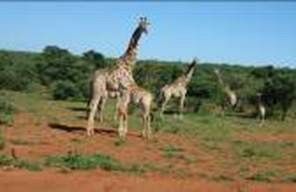December 2007 London Meeting
At our last London meeting before Christmas, we were treated to two excellent talks.
David Waldman told us about his trip to visit the Nandi of the Rift Valley in Kenya. Inspired to visit by athletes such as Kip Keno, David wanted to discover why this pocket of Kenya has produced over 50% of the long distance running world championship and Olympic medal winners since the 1960’s.
David discovered that running is not just a hobby or a sport, but an occupation, a possible escape from the poverty where those not gifted to run do jobs like breaking rocks or selling tomatos for $3 a day. Despite having no facilities at all, David found whole families who can all run world class marathon times. The runners do a 20km run in the mornings and another 10Km at night, their gym if you can call it that is a rock attached to either end of a metal bar. “Train hard, win easy” is their motto.
Those that make it to Europe can make more money from one race than the average Kenyan makes in a lifetime. They return to buy some land, build a house and farm, though once their running days are over many unfortunately descend into alcoholism. David had set out with the idea that there is a genetic reason for the running dominance, without doubt the altitude helps, but from early on they are out rounding up their cattle, they are doing the sheepdogs job.
And when a neighbouring village come to steal cattle they literally run after them with bows and arrows. There seems to be some degree of natural selection too, those that can run get the girls and produce more runners, the rest remain on the shelf.
Our second speaker was Jo Huxster, who should have been joined by Antonia Bolingbroke-Kent, who was ill. “Tuk to the road” was the story of Jo and Ants 12,500 mile, 12 countries in 14 week trip by Tuk Tuk from Bangkok to Brighton in aid of the Charity MIND.
Anyone who has taken a ride in one of these vehicles around an asian city will know it can be a bum numbing experience. Jo got the idea a couple of years previously while on holiday in Thailand.This was not going to be any old Tuk Tuk though, this was a custom built bright pink Tuk Tuk, which they christened Ting Tong, which actually means “crazy” in Thai.
They had decided on the northern route, via Laos, China, Kazakhstan, Russia, Ukraine, Poland, Germany and Belgium. So on 28th May 2006 they set off from Bangkok, crossing the Mekong into Laos, once the paperowrk issues had been resolved. Once in China a slight hitch occured when they discovered they were not allowed on the nice fast dual carriageways, instead they had to use what amounted to cart tracks which ran frustratingly alongside the main roads.
They had to race across China, as they only had a set amount of visa time, Jo particularly enjoyed the drive across the Gobi Desert. They had been fretting about the Kazakh border, but two girls in a pink Tuk tuk got taken to the front of the queue and they were soon crossing the green Kazakh countryside, one day they had to cover over 700Km as there was nothing inbetween. On their map the Kazakh M36 road to Russia was a nice fat red line, however the reality turned out to be one a track dirt road through fields.
The Russian police broke all records for pulling them over, they were stopped 35 times in 2 weeks! Ting Tong stood up to its journey quite well, however the shock absorbers that had taken 10 Chinese all night to repair broke again, but luckily a Ukranian mechanic was able to do the job on his own in a couple of hours, so they were soon on their way again. Once they crossed into the EU it was a case of pedal to the metal and head home, via the Channel Tunnel, arriving in Brighton on 3rd September. Globies raised in excess of £100 in a collection for MIND at the meeting.
If you want to learn more about Jo’s trip, buy the book or donate to the charity you can visit their website http://www.tuktotheroad.co.uk
By Padmassana
London meetings are held at The Church of Scotland, Crown Court, behind the Fortune Theatre in Covent Garden at 2.30pm the first Saturday of each month. There is no London meeting in August, but we will be back in September. For more information, you can contact the Globetrotters Info line on (+44) 020 8674 6229, or visit the website: www.globetrotters.co.uk

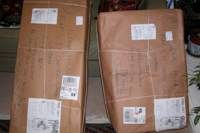 You don’t need to worry about getting your newly acquired purchases home as PNG Arts has a reliable packing, crating and shipping service, which the Beetle has twice used and all items arrived safely in London, taking about three months – see the very exciting picture left.
You don’t need to worry about getting your newly acquired purchases home as PNG Arts has a reliable packing, crating and shipping service, which the Beetle has twice used and all items arrived safely in London, taking about three months – see the very exciting picture left.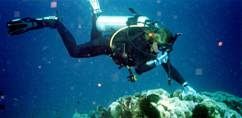 Anyway, down to business, this is not an ad for PNG Art, the Beetle wants to talk about Rabaul. Rabaul is a natural harbour on one of PNG’s islands, this one is New Britain, part of the Bismark Archipelago, which is immediately north of the main part of PNG. Rabaul has a sheltered deep harbour which allows good anchorage for large cargo and cruise ships. The harbour itself is a massive flooded caldera of an ancient volcano – it here that the Beetle did many fantastic dives. See the picture above right of a very undignified Beetle hanging on to some dead coral for dear life as the currents threatened to wash her away.
Anyway, down to business, this is not an ad for PNG Art, the Beetle wants to talk about Rabaul. Rabaul is a natural harbour on one of PNG’s islands, this one is New Britain, part of the Bismark Archipelago, which is immediately north of the main part of PNG. Rabaul has a sheltered deep harbour which allows good anchorage for large cargo and cruise ships. The harbour itself is a massive flooded caldera of an ancient volcano – it here that the Beetle did many fantastic dives. See the picture above right of a very undignified Beetle hanging on to some dead coral for dear life as the currents threatened to wash her away. From 1910 until 1937 Rabaul was under German control and the base of Japanese activities in the South Pacific during World War II and there are many remains and relics to be seen as a result of this and subsequent Japanese occupation.
From 1910 until 1937 Rabaul was under German control and the base of Japanese activities in the South Pacific during World War II and there are many remains and relics to be seen as a result of this and subsequent Japanese occupation. 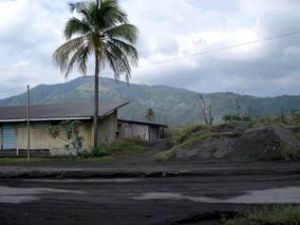
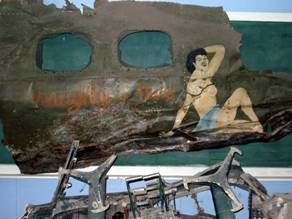 If you have an interest in WW2 artefacts and wish to gain a better understanding of the events in this part of the South Pacific, there is no better place to visit than the Kokopo war museum. It is largely set outdoor amidst beautifully manicured gardens with a gorgeous collection of frangipani ad star fruit trees.
If you have an interest in WW2 artefacts and wish to gain a better understanding of the events in this part of the South Pacific, there is no better place to visit than the Kokopo war museum. It is largely set outdoor amidst beautifully manicured gardens with a gorgeous collection of frangipani ad star fruit trees. 
 German colonial period, pre-war and WWII Japanese occupation such as tanks, search lights, munitions, motorcycles, half-tracks, guns, artillery, machine guns, and the wrecks and partial wreck of many Japanese aircraft.
German colonial period, pre-war and WWII Japanese occupation such as tanks, search lights, munitions, motorcycles, half-tracks, guns, artillery, machine guns, and the wrecks and partial wreck of many Japanese aircraft. 
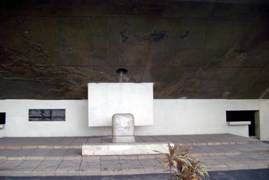 Japanese War Memorial A war memorial was constructed by the Japanese after WWII as a peace memorial, and in memory to those who lost their life in and around Rabaul. It is on a hill above the town, with a fabulous view of the area that was once occupied by thousands of Japanese Navy and Army personnel. The memorial is not without a little controversy. The huge map of the Pacific with New Britain and Rabaul at the centre forms the background of the memorial also
shows the sites of Jap
anese conquests. This elicited a response from the Australian government that the memorial signified Japanese occupation rather than promote their subsequent peaceful intentions. You can see in the Beetle photo left that there is a hole that lets the sun shine directly onto a simple pillar shrine.
Japanese War Memorial A war memorial was constructed by the Japanese after WWII as a peace memorial, and in memory to those who lost their life in and around Rabaul. It is on a hill above the town, with a fabulous view of the area that was once occupied by thousands of Japanese Navy and Army personnel. The memorial is not without a little controversy. The huge map of the Pacific with New Britain and Rabaul at the centre forms the background of the memorial also
shows the sites of Jap
anese conquests. This elicited a response from the Australian government that the memorial signified Japanese occupation rather than promote their subsequent peaceful intentions. You can see in the Beetle photo left that there is a hole that lets the sun shine directly onto a simple pillar shrine.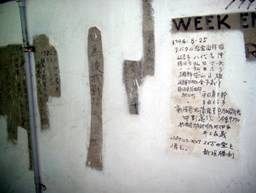
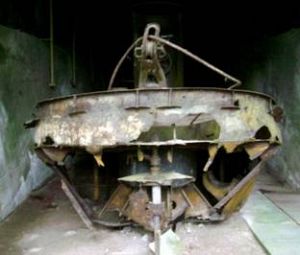 The Japanese used forced labour to build a series of tunnels through many parts of Rabaul. You can still see these tunnels sixty years later. Some of the tunnels were used to live in, store munitions and guns, and others were used to house barges. The Beetle photo left shows the remains of one such barge. One tunnel in particular is large enough to have stored five landing craft. During the war, these were carefully lifted out of the tunnel using a hoist system, taken across to the cliff face where they were lowered into the water.
The Japanese used forced labour to build a series of tunnels through many parts of Rabaul. You can still see these tunnels sixty years later. Some of the tunnels were used to live in, store munitions and guns, and others were used to house barges. The Beetle photo left shows the remains of one such barge. One tunnel in particular is large enough to have stored five landing craft. During the war, these were carefully lifted out of the tunnel using a hoist system, taken across to the cliff face where they were lowered into the water. 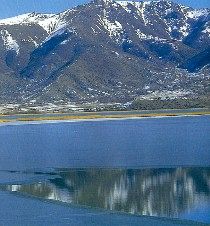 ooks dim. But the story here is Greek Macedonia, one of the most beautiful regions of Greece, and an area which will grow in importance as the commercial and cultural centre of the Balkans in the years to come.
ooks dim. But the story here is Greek Macedonia, one of the most beautiful regions of Greece, and an area which will grow in importance as the commercial and cultural centre of the Balkans in the years to come.  Founded by King Perdikas in the 7th Century BC it was formally known as Aigaes and was the first capital of Macedonia. When the capital was moved to Pella it was continued to be used as the royal burial grounds. In 336 BC, King Phillip II was assassinated by one of his seven bodyguards while attending the wedding of his daughter Cleopatra in the theatre.
Founded by King Perdikas in the 7th Century BC it was formally known as Aigaes and was the first capital of Macedonia. When the capital was moved to Pella it was continued to be used as the royal burial grounds. In 336 BC, King Phillip II was assassinated by one of his seven bodyguards while attending the wedding of his daughter Cleopatra in the theatre.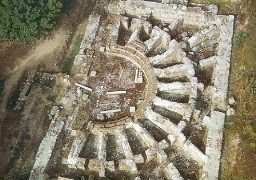 Ancient Dion was an important religious centre for worshipping the Gods of nearby Mount Olympus. This is where Phillip II came to celebrate his victories and his son Alexander came to make his sacrifices here before going off to conquer the East. While most of the statues which were not only found virtually intact, but with traces of colour, are in the nearby museum in the town of Dion, they have been replaced with copies. The Sanctuary of Isis is perhaps the most interesting discovery so far. An earthquake had displaced water and mud and the building was hidden for centuries under 6 feet of water which protected it from vandals. The temple still sits in the water and a copy of the statue of Aphrodite can be seen there.
Ancient Dion was an important religious centre for worshipping the Gods of nearby Mount Olympus. This is where Phillip II came to celebrate his victories and his son Alexander came to make his sacrifices here before going off to conquer the East. While most of the statues which were not only found virtually intact, but with traces of colour, are in the nearby museum in the town of Dion, they have been replaced with copies. The Sanctuary of Isis is perhaps the most interesting discovery so far. An earthquake had displaced water and mud and the building was hidden for centuries under 6 feet of water which protected it from vandals. The temple still sits in the water and a copy of the statue of Aphrodite can be seen there. 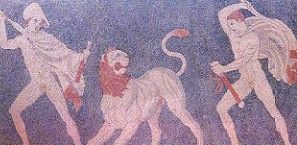 The Capital of Macedonia moved from Vergina to Pella in the 5th Century BC and was in effect the capital of Greece. Many people come here to see the exceptional mosaics discovered in the remains of houses and public buildings. The museum is one of Greece’s best on-site archaeology museums with a display of pottery, jewellery and mosaics found at the site. The remains of the buildings have impressed archaeologists and led them to believe that the Macedonians enjoyed a high level of wealth.
The Capital of Macedonia moved from Vergina to Pella in the 5th Century BC and was in effect the capital of Greece. Many people come here to see the exceptional mosaics discovered in the remains of houses and public buildings. The museum is one of Greece’s best on-site archaeology museums with a display of pottery, jewellery and mosaics found at the site. The remains of the buildings have impressed archaeologists and led them to believe that the Macedonians enjoyed a high level of wealth. 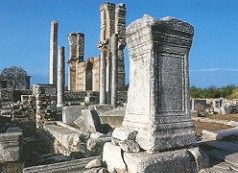 Site of the famous battle where the armies of Mark Anthony and Octavius met and defeated the armies of Julius Caesar’s assassins in 42BC. Brutas and Cassius committed suicide and the victors spent a fortune on Philippi, granting it the status of Roman Colony, providing us with the impressive ruins, and artefacts which are now in the museum. In 49 AD Saint Paul came to preach to the inhabitants of Philippi and ended up in prison. Despite Paul’s misfortune Phillipi was the first European city to accept Christianity, though the first two churches they built suffered some bad luck. The first was destroyed by an earthquake right after it was completed in the 5th century and the second collapsed before its dedication in the 6th Century because it was too top heavy. The remains can both be seen, as well as the ancient theatre built by Phillip II.
Site of the famous battle where the armies of Mark Anthony and Octavius met and defeated the armies of Julius Caesar’s assassins in 42BC. Brutas and Cassius committed suicide and the victors spent a fortune on Philippi, granting it the status of Roman Colony, providing us with the impressive ruins, and artefacts which are now in the museum. In 49 AD Saint Paul came to preach to the inhabitants of Philippi and ended up in prison. Despite Paul’s misfortune Phillipi was the first European city to accept Christianity, though the first two churches they built suffered some bad luck. The first was destroyed by an earthquake right after it was completed in the 5th century and the second collapsed before its dedication in the 6th Century because it was too top heavy. The remains can both be seen, as well as the ancient theatre built by Phillip II.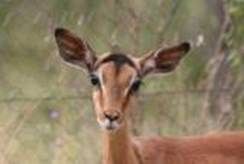 As the name suggests, Daktari is a wildlife orphanage that takes in injured, orphaned, or animals in general that for some reason can not be rehabilitated into the wild. People are educated in animal welfare, the environment and nature conservation by being part of teams which provide the nursing for the animals.
As the name suggests, Daktari is a wildlife orphanage that takes in injured, orphaned, or animals in general that for some reason can not be rehabilitated into the wild. People are educated in animal welfare, the environment and nature conservation by being part of teams which provide the nursing for the animals.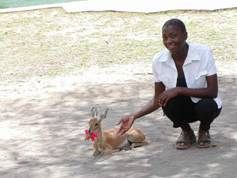 Daktari particularly targets underprivileged children from the surrounding rural areas. They are educated in the environment, life skills, and the care of the animals. Sadly, people from the local community suffer from the lack of access to their rich South African natural heritage even though they live right next to private game reserves. This has contributed to the high degree of poaching and environmental abuse in the area. We feel that by generating compassion and understanding, people will care for the environment.
Daktari particularly targets underprivileged children from the surrounding rural areas. They are educated in the environment, life skills, and the care of the animals. Sadly, people from the local community suffer from the lack of access to their rich South African natural heritage even though they live right next to private game reserves. This has contributed to the high degree of poaching and environmental abuse in the area. We feel that by generating compassion and understanding, people will care for the environment.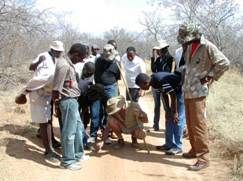 Daktari aims at inviting groups of underprivileged children to stay at the reserve, where they can learn about wildlife, teamwork, responsibility, have a hands-on experience, life skills, and by doing so, develop compassion towards animals. Unfortunately, many children end up unemployed after finishing high School. We expect that the education the children receive here will help them develop their skills and thus provide them with more work opportunities later in life, such as in the eco-tourism industry.
Daktari aims at inviting groups of underprivileged children to stay at the reserve, where they can learn about wildlife, teamwork, responsibility, have a hands-on experience, life skills, and by doing so, develop compassion towards animals. Unfortunately, many children end up unemployed after finishing high School. We expect that the education the children receive here will help them develop their skills and thus provide them with more work opportunities later in life, such as in the eco-tourism industry.